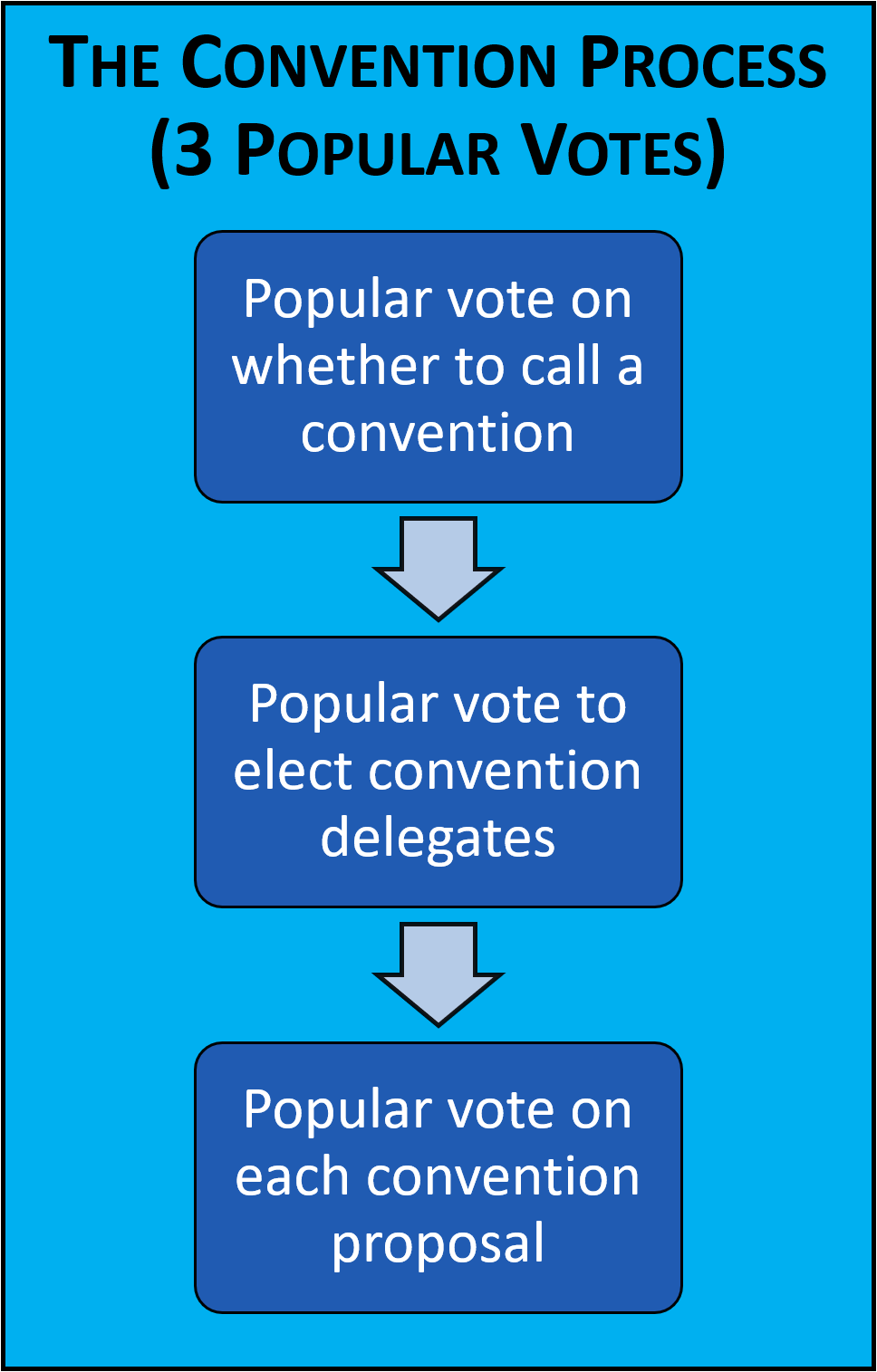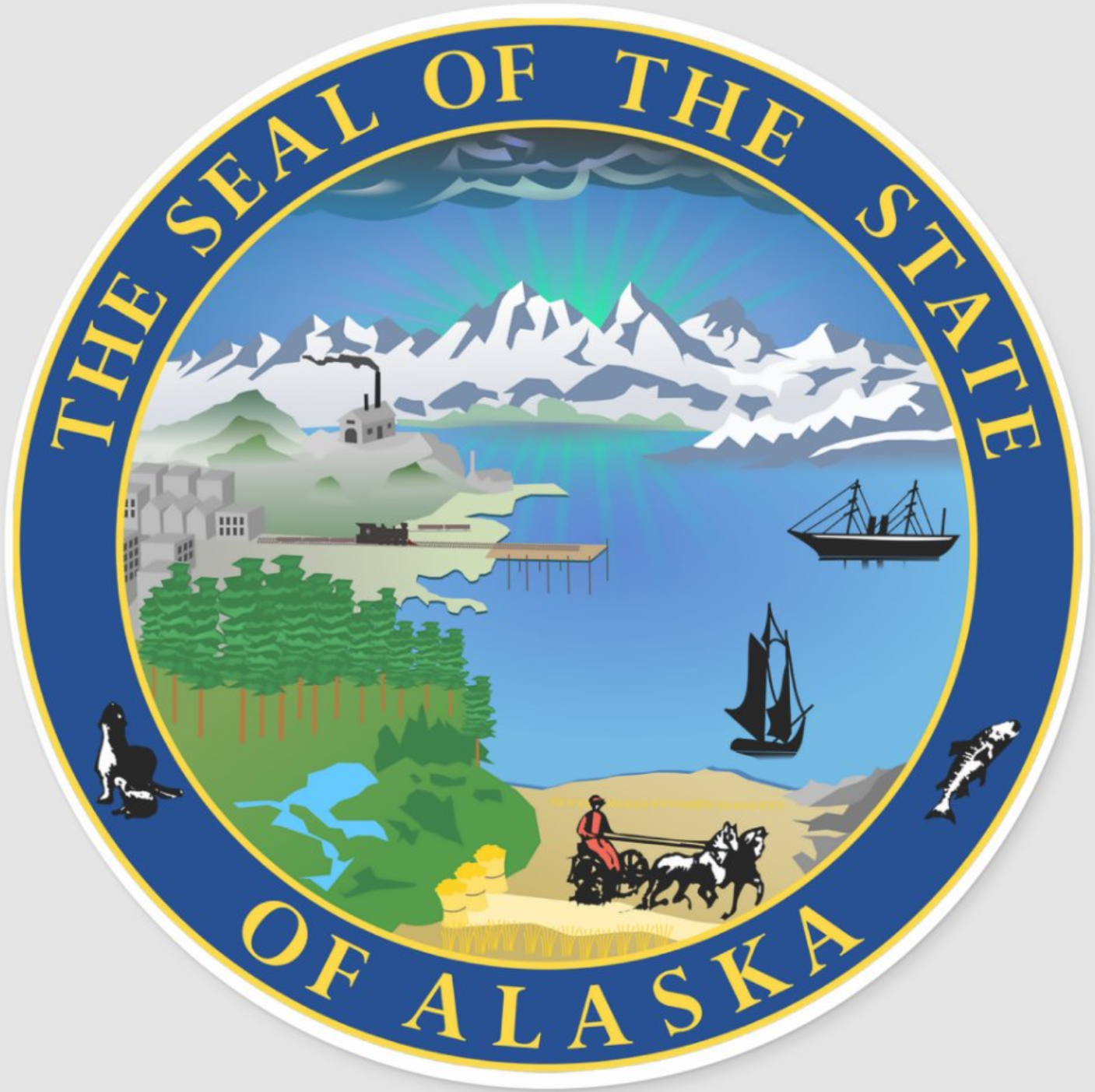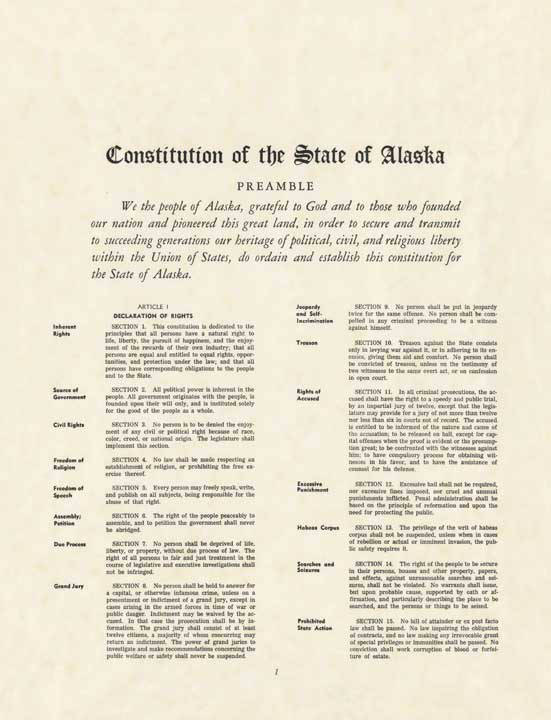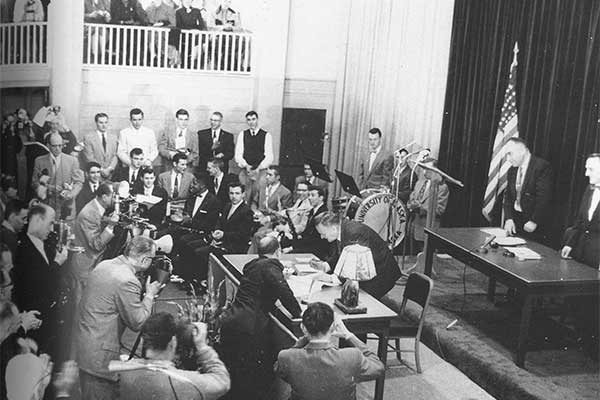This video tutorial is a relatively concise explanation why the constitutional convention referendum is on the ballot. For much more detailed information about the current debate about the constitutional convention referendum, click on FAQ on the menu above.
The Special Purpose of Alaska’s Periodic
Constitutional Convention Referendum
Alaska’s constitution provides two basic mechanisms to initiate constitutional reforms: legislature-initiated amendment and periodic referendum-initiated amendment. The unique democratic function of Alaska’s second process, its decennial constitutional convention referendum, is to implement the people of Alaska’s right to alter their constitution even when the interests of Alaska’s legislature and people conflict. Legislature initiated amendment gives Alaska’s legislature gatekeeping power over the proposal of amendments.
Alaska has another method for bypassing the legislature, the citizen statutory initiative, which is based on an initiative receiving a certain number of petition signatures. But in comparison to the periodic constitutional convention referendum, that method has significant limitations:*
-
- It can only be used to initiate statutes, not constitutional amendments.
- As it only creates a statute, the courts can overturn it at any time.
- It can only cover a “single subject,” a term which is ill-defined and been subject to much Alaska litigation.
- The legislature can prevent the initiative from being placed on the ballot by passing “substantially similar legislation,” even if that legislation undermines the purpose of the initiative.
- Immediately after the initiative passes, the legislature can pass amendments that undermine the statute created by the initiative.
- Two years after an initiative is approved by the voters, the legislature can repeal or otherwise render it completely ineffective.
The convention process seeks democratic accountability by granting the people three votes:
-
- To approve or reject calling a convention.
- To elect delegates to a convention.
- To approve or reject any amendments proposed by a convention.
An important limitation on the state constitutional convention process is that it cannot be used to pass a constitutional change that conflicts with Federal law, including the U.S. Constitution.
*See Bakalar, Elizabeth M. Alaska’s Ballot Initiative Today: History, Practice, and Process. Alaska L. Rev. 37 (2020): 153.
The constitutional convention referendum question as it appeared on Alaska’s statewide ballot in 2012. The wording of the text is mandated by Alaska’s Constitution, Article 13, Section 3 (see below).
J.H. Snider Op-eds on the Upcoming Referendum
Snider, J.H., Congrats to the anti-ConCon coalition: They’ve run a brilliant campaign, Juneau Empire, Nov. 1, 2022.
Snider, J.H., The lieutenant governor’s sizable role in the constitutional convention, Fairbanks Daily News-Miner, Oct. 20, 2022. For a copy of the article in the format of a news clipping, click here. The referenced public records requests can be found here.
Snider, J.H., Why is a convention referendum on the ballot this fall?, Juneau Empire, Oct. 6, 2022.
Snider, J.H., Apparent biases at work in creating pro-ConCon statement, Juneau Empire, June 8, 2022.
Snider, J.H., Derailing Alaska’s Constitutional Convention Referendum, Fairbanks Daily News-Miner, Feb. 20, 2022. For a copy of the article in the format of a news clipping, click here.
Snider, J.H., Preparing for Alaska’s constitutional convention referendum, Juneau Empire, Feb. 9, 2022.
The Three Key Popular Votes in the Convention Process

Senator Hughes Supporting a ConCon
Defending Our Constitution Opposing a ConCon
Senator Shower Explaining the ConCon Process
On July 25, 2022, Alaska State Senator Mike Shower defended the constitutional convention process at the “school of government” in Wasilla. Included in his description are the three public votes that are part of the process, the distrust of opponents who believe the public cannot be trusted to vote in their own self-interest, and the unique democratic function of the convention process, which is to provide the people with an option to bypass the legislature when proposing constitutional amendments for public approval or disapproval. Senator Shower’s presentation begins at 13.5 minutes and ends at 52 minutes. Q&A continues to 1:37. The balance of time was for announcements. Click on the image below for the video.
Key Passages from Alaska’s Constitution
Article 1
Declaration of Rights
Section 1.2 – Source of Government. All political power is inherent in the people. All government originates with the people, is founded upon their will only, and is instituted solely for the good of the people as a whole.
Article 13
AMENDMENT AND REVISION
Section 13.1 – Amendments.
Amendments to this constitution may be proposed by a two-thirds vote of each house of the legislature. The lieutenant governor shall prepare a ballot title and proposition summarizing each proposed amendment, and shall place them on the ballot for the next general election. If a majority of the votes cast on the proposition favor the amendment, it shall be adopted. Unless otherwise provided in the amendment, it becomes effective thirty days after the certification of the election returns by the lieutenant governor.
Section 13.2 – Convention.
The legislature may call constitutional conventions at any time.
Section 13.3 – Call by Referendum.
If during any ten-year period a constitutional convention has not been held, the lieutenant governor shall place on the ballot for the next general election the question: “Shall there be a Constitutional Convention?” If a majority of the votes cast on the question are in the negative, the question need not be placed on the ballot until the end of the next ten-year period. If a majority of the votes cast on the question are in the affirmative, delegates to the convention shall be chosen at the next regular statewide election, unless the legislature provides for the election of the delegates at a special election. The lieutenant governor shall issue the call for the convention. Unless other provisions have been made by law, the call shall conform as nearly as possible to the act calling the Alaska Constitutional Convention of 1955, including, but not limited to, number of members, districts, election and certification of delegates, and submission and ratification of revisions and ordinances. The appropriation provisions of the call shall be self-executing and shall constitute a first claim on the state treasury.
Section 13.4 – Powers.
Constitutional conventions shall have plenary power to amend or revise the constitution, subject only to ratification by the people. No call for a constitutional convention shall limit these powers of the convention.
Article 9
FINANCE AND TAXATION
[Based on press accounts in fall 2021 and early 2022, Alaskans’ choice whether to call a state constitutional convention may depend on whether a) there is popular support for changing the constitutional provision related to the Permanent Fund (see below), b) the public thinks the legislature is too dominated by special interests to make the change in the public interest, and c) the public thinks the constitutional convention process will be less corrupt than the legislative process for dealing with such constitutional issues.]
Section 9.15 – Permanent Fund
At least twenty-five per cent of all mineral lease rentals, royalties, royalty sale proceeds, federal mineral revenue sharing payments and bonuses received by the State shall be placed in a permanent fund, the principal of which shall be used only for those income-producing investments specifically designated by law as eligible for permanent fund investments. All income from the permanent fund shall be deposited in the general fund unless otherwise provided by law. [Amended 1976]
Source: Entire Consitution of the State of Alaska. Article XIII of the Constitution of the State of Alaska. Article IX of the Constitution of the State of Alaska.
Alaska’s Statutory Initiative
(Source: Alaska Initiative and Referendum Processes, National Conference of State Legislatures, Accessed 2/25/2022.)
Types and Year Established
- Year established: 1959
- Types allowed: Indirect initiative for statutes only and popular referendum
Allowable Subject Matter
- Single subject rule: Yes (AS § 15.45.040)
- Other subject restrictions: Cannot: dedicate revenue, repeal appropriations, create courts, define court rules or jurisdictions, or enact local or special legislation (AS § 15.45.010)
- Repeat measures: No statute
Petition Application Process
- Application process information: Signatures of 100 qualified voters filed with lieutenant governor and deposit of $100 which is refunded when petition is properly filed (AS § 15.45.020; 15.45.030).
- Where to file with: Lieutenant governor’s office (AS § 15.45.020)
- Proponent organization and requirements: Petition designates committee of three sponsors (AS § 15.45.030)
- Proponent financial disclosure requirements: Include, but not limited to, group name, reports, contributions, dollar amounts and deadlines (AS § 15.13.040; § 15.13.050; § 15.13.065; § 15.13.110)
- Withdrawal of petition: No statute
Petition Content
- Petition title and summary creation: Lieutenant governor (AS § 15.45.090)
- What is on each petition: Sequentially numbered, copy of the proposed bill, impartial summary, statement of costs, space for signatures, date, address, and other specifications prescribed by the lieutenant governor (AS § 15.45.090)
Petition Review, Creation and Public Notice
- Who creates petitions: Lieutenant governor (AS § 15.45.090)
- Fiscal review: Lieutenant governor provides statement of costs (AS § 15.45.090)
- General review of petition: Lieutenant governor reviews within 60 days of receiving (AS § 15.45.150)
- Legislature or other government official review: No additional statute found other than the indirect initiative design, requiring initiative to be turned into the legislature before appearing on the ballot
- Public review or notice: Thirty days or more before election, lieutenant governor holds public hearings with proponent and opponents (AS § 15.45.195). Election board reviews copies of proposed law and will display one copy in public place (AS § 15.45.200).
Circulators
- Circulator requirements: U.S. citizen, age 18 or older and legal Alaskan resident (AS § 15.45.105)
- Circulator oaths or affidavits: Yes, before signature sheets are filed (AS § 15.45.130)
- Paid per signature: Allowed, but not greater than $1 per signature (AS § 15.45.110)
- Allowed to pay another for their signature: Prohibited (AS § 15.45.110)
Signatures
- Number of signatures required: Ten % of total votes cast in previous general election with geographic requirement (AS § 15.45.140)
- Who can sign the petition: Qualified voters (AS § 15.45.140)
- Geographic distribution: Yes, from three-fourths of house districts of the state with signatures from each district equaling at least 7 % of the total votes from preceding general election (AS § 15.45.140)
- Collected in-person: Yes (AS § 15.45.110)
- Withdrawal process of individual signature: Written notice to lieutenant governor before petition is filed (AS § 15.45.120)
- Verification: Lieutenant governor counts and checks for validity (15.45.150)
Submission Timelines and Deadlines
- Timeline for collecting signatures: Filed within one year of receiving notice that petitions are ready (AS § 15.45.140)
- Submission deadline of signatures: Same as above
Ballot Access and Preparation
- Which election is a measure on: The first statewide general, special, special runoff, or primary election after the petition has been filed, a legislative session has convened and adjourned, and a period of 120 days has expired since the adjournment of the legislative session (AS § 15.45.190)
- Ballot title and summary: Lieutenant governor with assistance from attorney general (AS § 15.45.180)
- Time-period restrictions before placed on the ballot: First election 120 days after adjournment of the legislative session (AS § 15.45.190)
The Election and Effect
- Conflicting measures: Lieutenant governor and attorney general may determine that an act passed by the legislature is substantially the same as the proposed law by initiative, and was passed after the initiative was filed but before the election, the initiative is void and does not appear on the ballot (AS § 15.45.210).
- Majority to pass: Yes (AS § 15.45.220)
- Timeline for taking effect: Ninety days after certification (AS § 15.45.220)
- Repeal or change restrictions: Cannot within two years of effective date, not subject to veto, can be amended by majority vote (AK Const. Art. 11, § 6)
Alaska’s State Constitution Day
On August 30, 2021, legislation (Alaska Stat. § 44.12.137) creating the ‘Constitution of the State of Alaska Day,’ came into effect. “School assemblies” are expected to “observe” it.
According to the Democratic Party press release announcing the new day, Alaska’s Constitution guararentees “that the individual will always be in-charge.” Constitution Day seeks to foster admiration for the constitution: “The 55 delegates to the Alaska constitutional convention provided a visionary template for guided governance that has served this state well.”
Key Government Milestones
May 17, 2022. Original deadline to submit pro and con statements to the Lt. Governor for inclusion in the election pamphlet mailed to all Alaskans.
June 30, 2022. Revised deadline to submit pro and con statements to the Lt. Governor for inclusion in the election pamphlet mailed to all Alaskans.
Oct. 10, 2022. Election pamphlet mailed to all Alaskan registered voters.
Nov. 8, 2022. Election day.

Countdown until Nov. 8, 2022
Day(s)
:
Hour(s)
:
Minute(s)
:
Second(s)
Alaska Division of Elections
Final Election Results
Vote |
Total |
% of Votes |
| Yes | 75,723 | 29.55% |
| No | 180,529 | 70.45% |
| Total Yes + No Votes | 256,252 | 100% |
| Total Ballots Cast | 266,943 | |
| Total Registered Voters | 601,161 |
Governor Mike Dunleavy (third from left) holds a sign supporting a convention call at a gubernatorial debate on Oct. 11, 2022. The candidates were evenly divided in supporting and opposing the convention call. (Click image for source.)
J.H. Snider Articles
in Blog Format

Congrats to the anti-ConCon coalition: They’ve run a brilliant campaign.
Congratulations are due to Defend Our Constitution for its $3 million campaign against calling an Alaskan constitutional convention, which is on the ballot Nov. 8. It has run a brilliant no campaign by artfully turning its disadvantages into advantages. Consider these examples: Alaska’s framers designed the convention process to be a mechanism to bypass the legislature’s gatekeeping power over...

The lieutenant governor’s sizable role in the constitutional convention
On Oct. 10, every Alaskan was mailed an election pamphlet for the Nov. 8 election. Included were statements in support and opposition to calling a constitutional convention. The Lieutenant Governor is granted the power to choose those pro and con statements. Alas, since there is no meaningful check on that power, he can use it to bias the election result. Consider his remarkable power over the pro statement:

Why is a convention referendum on the ballot this fall?
Alaska’s framers understood that the process of ordinary and higher lawmaking should be different. Once per decade — next on Nov. 8 — Alaska’s constitution grants the people the right to call a constitutional convention via a statewide referendum. Alaska’s Framers placed this automatic referendum on the ballot to prevent the Legislature from having monopoly power over initiating constitutional...

Apparent biases at work in creating pro-ConCon statement
In 1970, the first time the decennial referendum on whether to call a constitutional convention was on Alaska’s ballot, Alaskans voted yes. In 1972, Alaska’s Supreme Court overturned that result, ruling that the referendum had been biased in favor of calling a convention because it misleadingly implied that the constitution mandated “a convention rather than the referendum.” Never mind that under that interpretation it would have been illogical to put the referendum on the ballot, let alone extensively debate it in the news media.

Derailing Alaska’s Constitutional Convention Referendum
Once per decade, Alaska’s constitution grants the people the right to call a constitutional convention via a statewide referendum. The democratic function of the referendum is to prevent the legislature from having monopoly proposal power over constitutional amendment. This fall the referendum is next on the ballot. Opponents, led by Defend Our Constitution, a who’s who of Alaska’s insiders,...

Preparing for Alaska’s constitutional convention referendum
On Nov. 8, 2022, Alaskans will be asked whether they want to convene a state constitutional convention. Alaska’s constitution mandates this question be placed on the ballot every 10 years. This periodic constitutional convention referendum allows the people to bypass the legislature when proposing constitutional reforms. This enhances democracy because the legislature has an inherent conflict of...

Constitutional Highlights
[On the people’s sovereignty, including its constituent power to amend the state’s constitution despite the legislature’s opposition]
“All political power is inherent in the people. All government originates with the people, is founded upon their will only, and is instituted solely for the good of the people as a whole.”
–Alaska Constitution,
Article 1, Section 2
[On the Framers’ mistrust of the legislature to call a convention, even if the constitution mandated such a call.]
“ The lieutenant governor shall issue the call for the convention.”
–Alaska Constitution,
Article 13, Section 3
[On the legislature not being allowed to limit a constitutional convention’s agenda to preserve it as a legislative bypass mechanism]
“Constitutional conventions shall have plenary powers to amend or revise the constitution, subject only to ratification by the people. No call for a constitutional convention [issued by the legislature] shall limit these powers of the convention.”
–Alaska Constitution,
Article 13, Section 4

On the Statutory Initiative
[On Alaska’s statutory initiative as a legislative bypass mechanism–but only for statutes, not constitutional amendments]
“[T]he delegates’ intent [was] that the
initiative serve as the people’s check on the legislature. Under our system of checks and
balances, when the legislature fails to pass laws the people believe are needed, the people have the initiative power to create those laws..”
–Alaska Supreme Court,
Meyer v. Alaskans for Better Elections,
465 P.3d 477, 497 (Alaska 2020).
[On the purpose of the statutory initiative as a legislative bypass mechanism]
“Mr. President, the only value for the initiative and referendum procedure is if there is a clear channel for enactment of legislation by the people. That is, if it goes directly from the people bypassing the legislature. If you give the legislature the power to block that channel, then you just as well as have no initiative and referendum at all. ”
–Delegate W.O. Smith,
Alaska Constitutional Convention,
Dec. 19, 1955
On the Periodic Constitutional Convention Referendum
[On the purpose of the periodic constitutional convention referendum as a legislative bypass mechanism analogous to the statutory initiative but better suited for constitional amendments]
“I cast my vote against the initiative on constitutional amendments… because I felt that the people still could, if they wanted to, adopt a specific amendment, could vote in favor of a constitutional convention. Should the constitutional convention be limited to revision, it implies that they could not amend, and I don’t think that is a proper amendment.”
–Delegate V. Fischer,
Alaska Constitutional Convention,
Jan. 5, 1956
[On the constitutonal convention as a flawed democratic mechanism like all democratic mechanisms]
“Perhaps you can draw strength and comfort from the words of Alexander Hamilton in ‘The Federalist No. 85,’ the final essay in the series in which he gives an answer to all [charges of imperfections]: ‘I never expect to see a perfect work from imperfect man.’”
–Governor B. Frank Heintzleman,
Alaska Constitutional Convention,
Closing Session Speech, Feb. 5, 1956
[On why a legislature shouldn’t substitute for a constitutional convention]
“Many other issues will be before the people when they are considering what men they should elect to their legislature. They will not be thinking primarily of the proposed amendment to the constitution.
I feel strongly that the constitution of the State of Alaska should be amended, if at all, only by the people directly, and that their ratification be secured by their own votes and not through electing some man to the legislature whenever an amendment is proposed.”
–Delegate Maynard Sundborg,
Alaska Constitutional Convention,
Jan. 5, 1956
[On why a legislature shouldn’t be given any discretion on whether a constitutional convention shoul be called]
“[The Committee on Future Amendments] desired to make this as nearly as possible self-executing so that the legislature… could not prevent the [people] getting a constitutional convention if the legislature didn’t want one, which probably the legislature would not….”
–Delegate Maynard Sundborg,
Alaska Constitutional Convention,
Jan. 28, 1956
[On the intent of the committee on future amendments and direct democracy to allow the initiative to be used to call a convention but not to directly propose constitutional amendments]
“[I]t was the intent of the Committee that through the initiative they could initiate a call for the convention, but the people could not initiate an amendment to the constitution itself.”
–Delegate Jack Hinckel,
Alaska Constitutional Convention,
Jan. 28, 1956
[On the intent of the convention delegates to provide the people of Alaska with the periodic constitutional convention referendum so as to have the option of bypassing the legislature]
“The delegates felt that revision of the constitution should not be at the mercy of future state legislatures. Consequently, the people are to be permittted to vote at least once every ten years on whether or not to have a constitutoinal convention.”
–John E. Bebout, Consultant
Alaska Constitutional Convention,
and Author of
“Charter for Last Frontier,” 1956
[On the National Municipal League’s Model State Constitution, which convention consultant to the delegates John Bebout described as “constantly referred to and used as language, ideas and argument.”]
“Formal constitutional change involves two distinct steps–proposal and approval…. Some way should be provided by which the people may directly effect constitutional change without depending on existing governmental institutions. Section 12.03 [Constitutional Conventions] is designed to insure popular control over the revision process by convention. It also assures the constitutional convention of independence from the established governmental institutions, particularly the legislature…. Subsection 12.03 (a) supports the principle of periodic submission of the question of calling a convention…. In order more fully to guarantee popular control, the subsection provides for submission of the question directly to the people without legislative action.”
–Model State Constitution, 6th Edition
National Municipa League, 1963
On the Use of the Statutory Initiative to Call a Constitutional Convention
[On the intent of the committee on future amendments and direct democracy to allow the initiative to be used to not only call a convention but to propose an enabling act for it]
“I am convinced that the word ‘legislature’ in Section 2 means that the people can, by the initiative, pass an act calling a constitutional convention and making provision in it.”
–Delegate George McLaughlin,
Alaska Constitutional Convention,
Jan. 28, 1956


